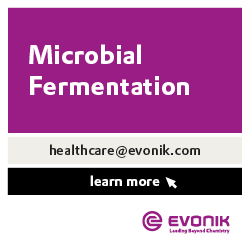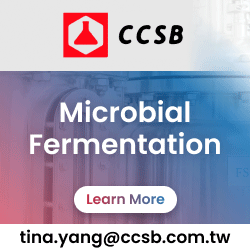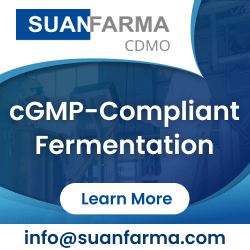BLOG
MARKET INTEL by PharmaCompass
CONTENT by Suppliers
- Interview #SpeakPharma
- Video #SupplierSpotlight
- Vlog #PharmaReel
- Company Bio #AboutSupplier
- Service Bio #AboutCapabilities
News
Create content with us, ask us


- CONTRACT MANUFACTURING
- CYTOTOXIC COMPOUND
- ANTIBIOTIC
- ANTIBODY DRUG CONJUGATE
- BIOLOGICS, BIOPROCESS & FERMENTATION
- CHIRAL SYNTHESIS
- CLINICAL SUPPLY
- CONTINUOUS FLOW PROCESS
- CONTROLLED SUBSTANCE
- CUSTOM SYNTHESIS & MANUFACTURING
- DISTILLATION / LIQUID API
- DRYING
- FINE CHEMICAL / INTERMEDIATE
- GMP MANUFACTURING
- HALOGENATION
- HAZARDOUS CHEMISTRY
- HIGH POTENCY APIS (HPAPIS)
- HIGH PRESSURE REACTION (> 100 PSI)
- HIGH TEMPERATURE REACTION (> 200 °C)
- HYDROGENATION
- LOW TEMPERATURE / CRYOGENIC CONDITIONS
- LYOPHILIZATION
- MICRONIZATION
- ORGANOMETALLIC CHEMISTRY
- OZONOLYSIS
- PHOSGENATION
- PLANT EXTRACTION
- PROBIOTIC
- PROCESS DEVELOPMENT & OPTIMIZATION
- PROCESS SAFETY ASSESSMENT
- PROTEIN / PEPTIDE
- REFERENCE STANDARD
- RESOLUTION OF RACEMIC MIXTURE
- SCALE UP
- SEPARATION & PURIFICATION
- SMALL SCALE BATCH
- INJECTABLE / STERILE APIS
- STEROID / HORMONE
- VITAMINS / MINERALS / INORGANIC SALTS
- CHROMATOGRAPHY
- OLIGOSACCHARIDES & POLYSACCHARIDES
- SMALL MOLECULES
- OLIGONUCLEOTIDE / POLYNUCLEOTIDE
- BIOPOLYMERS

01 Overview
02 Overview
03 Overview
04 Overview
05 Overview
06 Overview
07 Overview
08 Overview
09 Overview
10 Overview
11 Overview
12 Overview

01 3PBiovian
02 53Biologics
03 APC Ltd
04 Anthem Biosciences
05 Bio-Technology General Israel Ltd.
06 BioInno Bioscience
07 BioInnovatise
08 Bioplus Life Sciences
09 Cambrex Corporation
10 Chunghwa Chemical Synthesis & Biotech
11 Concord Biotech
12 Curia
13 EUROAPI
14 EirGenix
15 Eurofins CDMO
16 Evonik
17 Farmhispania
18 Fluart Innovative Vaccines
19 GBI
20 KBI Biopharma
21 Lupin Manufacturing Solutions
22 NorthX Biologics
23 Olon S.p.A
24 Pfanstiehl
25 Pfizer CentreOne
26 Phyton Biotech LLC
27 Porton Pharma Solutions
28 Premas Biotech
29 Seqens
30 Suanfarma
31 Symbiotec Pharmalab
32 TAPI Technology & API Services

01 Canada
02 China
03 France
04 France
05 France
06 Germany
07 Hungary
08 India
09 India
10 India
11 Ireland
12 Israel
13 Israel
14 Italy
15 Spain
16 Spain
17 Sweden
18 Taiwan
19 Taiwan
20 U.S.A
21 U.S.A
22 U.S.A
- Analytical > Analytical Method Development
- Analytical > Analytical Testing Services > Inhalation Products
- Analytical > BioAnalytical Services
- API & Drug Product Development > API Development
- API & Drug Product Development > API Development > Antibody Drug Conjugate
- API & Drug Product Development > API Development > Fine Chemical / Intermediate
- API & Drug Product Development > API Development > High Potency APIs (HPAPIs)
- API & Drug Product Development > API Development > Impurity / Reference Standard
- API & Drug Product Development > API Development > Oligonucleotide / Polynucleotide
- API & Drug Product Development > API Development > Oligosaccharides & Polysaccharides
- API & Drug Product Development > API Development > Overview
- API & Drug Product Development > API Development > Process Development & Optimization
- API & Drug Product Development > API Development > Protein / Peptide
- API & Drug Product Development > API Development > Separation & Purification
- API & Drug Product Development > API Development > Small Molecules
- API & Drug Product Development > API Development > Spray Drying
- API & Drug Product Development > Formulation Development
- API & Drug Product Development > Formulation Development > Buccal / Orodispersible
- API & Drug Product Development > Formulation Development > Capsule
- API & Drug Product Development > Formulation Development > Chewable / Suckable
- API & Drug Product Development > Formulation Development > Clinical Supply
- API & Drug Product Development > Formulation Development > Compounding
- API & Drug Product Development > Formulation Development > Controlled / Immediate / Modified Release
- API & Drug Product Development > Formulation Development > Controlled Substance
- API & Drug Product Development > Formulation Development > Granule / Pellets
- API & Drug Product Development > Formulation Development > Inhalation / Nasal
- API & Drug Product Development > Formulation Development > Injectable / Parenteral
- API & Drug Product Development > Formulation Development > Liquid Formulation
- API & Drug Product Development > Formulation Development > Lyophilization
- API & Drug Product Development > Formulation Development > Ophthalmic
- API & Drug Product Development > Formulation Development > Pediatric Formulation
- API & Drug Product Development > Formulation Development > Scale-Up Capabilities
- API & Drug Product Development > Formulation Development > Sterile Liquid Formulation
- API & Drug Product Development > Formulation Development > Suspension
- API & Drug Product Development > Formulation Development > Tablet
- API & Drug Product Development > Formulation Development > Topical
- API & Drug Product Development > Preformulation & Material Science > Particle Size Reduction & Micronization
- API & Drug Product Development > Preformulation & Material Science > Polymorph & Crystal Screening
- API & Drug Product Development > Preformulation & Material Science > Solubility Assessment & Enhancement
- API & Drug Product Development > Preformulation & Material Science > Taste Masking
- API Manufacturing > Antibiotic
- API Manufacturing > Antibody Drug Conjugate
- API Manufacturing > Biologics, Bioprocess & Fermentation
- API Manufacturing > Chiral Synthesis
- API Manufacturing > Clinical Supply
- API Manufacturing > Continuous Flow Process
- API Manufacturing > Contract Manufacturing
- API Manufacturing > Controlled Substance
- API Manufacturing > Custom Synthesis & Manufacturing
- API Manufacturing > Cytotoxic Compound
- API Manufacturing > Drying > Spray Drying
- API Manufacturing > Fine Chemical / Intermediate
- API Manufacturing > GMP Manufacturing
- API Manufacturing > Hazardous Chemistry
- API Manufacturing > High Potency APIs (HPAPIs)
- API Manufacturing > Micronization
- API Manufacturing > Oligonucleotide / Polynucleotide
- API Manufacturing > Oligosaccharides & Polysaccharides
- API Manufacturing > Organometallic Chemistry
- API Manufacturing > Organometallic Chemistry > Cyanation
- API Manufacturing > Organometallic Chemistry > Metal Hydride Reduction
- API Manufacturing > Ozonolysis
- API Manufacturing > Process Development & Optimization
- API Manufacturing > Protein / Peptide > Synthesis
- API Manufacturing > Reference Standard
- API Manufacturing > Scale Up
- API Manufacturing > Separation & Purification
- API Manufacturing > Small Molecules
- Clinical Trials > Compliance, Regulatory & Consulting
- Clinical Trials > Packaging & Logistics
- Clinical Trials > Medical Writing & Language Translation
- Clinical Trials > Patient / Investigator Recruitment
- Clinical Trials > Technology / Data / Analytics
- Drug Product Manufacturing > Biologic Drugs
- Drug Product Manufacturing > Capsule
- Drug Product Manufacturing > Capsule > Steroid / Hormone
- Drug Product Manufacturing > Compounding
- Drug Product Manufacturing > Cream / Lotion / Ointment
- Drug Product Manufacturing > Emulsion > Overview
- Drug Product Manufacturing > Gel > Overview
- Drug Product Manufacturing > Granule / Pellet
- Drug Product Manufacturing > Injectable / Parenteral
- Drug Product Manufacturing > Injectable / Parenteral > Overview
- Drug Product Manufacturing > Injectable / Parenteral > Pre-Filled Syringe
- Drug Product Manufacturing > Liquid
- Drug Product Manufacturing > Lyophilization
- Drug Product Manufacturing > Nasal
- Drug Product Manufacturing > Softgel Capsule
- Drug Product Manufacturing > Solution > Overview
- Drug Product Manufacturing > Spray
- Drug Product Manufacturing > Suppository
- Drug Product Manufacturing > Suspension > Overview
- Drug Product Manufacturing > Syrup
- Drug Product Manufacturing > Tablet
- Drug Product Manufacturing > Technologies
- Drug Product Manufacturing > Technologies > Orally Disintegrating Tablets (ODTs)
- Drug Product Manufacturing > Technologies > Taste Masking
- Packaging > Clinical Services
- Packaging > Contract Services
- Packaging > Contract Services > Serialization Compliance
- Packaging > Logistic Services
- Empty Capsules
- Empty Capsules > Clinical Supply
- Empty Capsules > HardGel
- Empty Capsules > Inhalation
- Emulsifying Agents
- Soft Gelatin
- Solubilizers
Overview of fermentation offered by biotech CDMOs & contract manufacturers for food products, probiotics, small molecules, chemicals, APIs & enzymes.
Q1. What is microbial fermentation?
Fermentation is the transformation of organic substances into simpler compounds by the action of enzyme production via microorganisms such as molds, yeasts, or bacteria. Enzyme production catalyzes fermentation by enabling hydrolysis reactions that break down complex sugars and other molecules into simpler units. Hydrolysis is an exothermic, decomposition reaction that uses water to break down polymers into monomers.
In the field of biotechnology, fermentation refers to any process by which microorganisms are grown in large quantities to produce many types of useful materials. Microorganisms used in biotechnological fermentation and involved in enzyme production, amongst other things, include, bacteria (e.g. E. coli - most commonly used microorganism in microbial fermentation), algae, fungi, and actinomycetes.
Biotechnological microbial fermentation services are offered by biotech contract manufacturing organizations (CMOs) and biotech CDMOs to grow microorganisms on a medium, usually with the end goal of manufacturing a variety of chemicals, small and large molecules for clinical & commercial supply.
Biotechnological microbial fermentation services offered by biotech CDMOs are the basis for the production of a wide range of pharmaceutical products, targeting practically any medical indication. Fermentation produces small molecules such as short peptides and low molecular weight organic molecules, larger molecules including proteins and nucleic acids (DNA, RNA) and macromolecules, plus various combinations of product types, which could potentially serve as Active Pharmaceutical Ingredients (APIs) for clinical & commercial supply.
Contract development & manufacturing organizations offer a range of pharmaceutical CDMO services, which may include enzymes and microbial fermentation processes. Contract manufacturers, focused on enzyme and microbial fermentation services, are usually involved in custom API synthesis and can be referred to as pharmaceutical CDMOs for fermented APIs.
The rate of outsourcing of fermentation processes to contract manufacturers and pharmaceutical CDMOs for fermented APIs is on the rise. The value of the global contract pharmaceutical fermentation service market is predicted to surpass $4.0 billion by the end of 2026, expanding at a CAGR of 5.9%.
The production of bulk chemicals, pharmaceuticals, biofuels, etc. via microbial fermentation processes is relatively new, as fermentation's traditional use was limited to food preservation. However, since then its applicants have expanded, and currently microbial fermentation is used in the production of the pharmaceutical products noted below.
- Industrial chemical solvents
- Enzymes
- Amino Acids
- Vitamins
- Pharmaceutical Antibiotics
- Etc.
Overall, microbial fermentation based GMP manufacturing provides faster development, higher yields and quality, reduced variation between batches, better scalability, and lower production costs. There are various steps and copious technologies that enable enzyme and microbial fermentation processes, which are explored in detail below.
Q2. What are the different steps involved in large scale microbial fermentation?
Biotech contract manufacturing organizations (CMOs) and biotech CDMOs for fermented APIs have the fermentation capacity, technologies and integrated fermentation processes development & manufacturing capabilities to perform large scale microbial fermentation. Large scale microbial fermentation is completed in a series of steps by contract development & manufacturing organizations. The progression of the most important stages of industrial fermentation are enumerated below.
1. Strain Selection & Optimization
A strain (virus, bacterium, or fungus) is selected on the basis of the following criteria:
- Supports large-scale production of desired microbial products.
- Microorganism is well-defined.
- It grows fast and is safe to handle.
- Compatible with media, and requires only minimal to moderate amounts.
- Reduces production costs.
- Beneficial for isolation procedures during integrated fermentation process development and manufacturing.
- Stable, simple to understand, and easy to manipulate genetically.
After strain selection, the next step in microbial fermentation is strain optimization. Advances in recombinant DNA technology have made it possible for engineering improved microbial strains by the addition or deletion of certain genes.Improvement of microbial strains for the over-production of industrial products has been the hallmark of all commercial and industrial fermentation processes by contract manufacturers. Strain optimization can be achieved by mutation and selection processes.
- Mutation & Selection: Mutations occur spontaneously in nature, however, during microbial fermentation microorganisms are exposed to mutagenic agents such as UV rays and chemicals, to increase the rate of changes in DNA. The best mutation isolate is then selected via effective screening of the resulting mutants. This is done to improve the metabolic properties of the microbial starter cultures used for fermentation.
2. Media & Process Development
After strain selection and optimization, comes media and process development. Medium selection and development are essential fermentation capacities as microorganisms require water, vitamins, nitrogen, carbon. oxygen, energy, etc. to grow.
A suitable media (synthetic, semisynthetic or complex) is selected if it satisfies the the following criteria:
- Produces maximum yield of desired product.
- Will allow integrated fermentation process development and manufacturing to run at the highest rate possible.
- Yields minimal amounts of undesirable byproducts.
- Is consistent in quality.
Following media selection, integrated fermentation process development and manufacturing is the strategy via which a GMP manufacturing route is identified for a pharmaceutical product from an early stage through scale up to clinical & commercial supply. It anticipates and identifies development and GMP manufacturing steps which could affect the quality of the product, in order to control these variables during large scale microbial custom API synthesis.
Therefore, media and process development are essential stages that contribute to designing successful scale up strategies for large scale industrial fermentation production.
3. Fermentation & Scale Up
The next step in large scale fermentation is actually carrying out fermentation, which can be achieved in one of three ways.
- Batch Culture Fermentation: Fermentation is carried out in a closed fermenter, with nothing added or removed during the process (except venting of gas). Microorganisms and nutrients are left for a set period of time, during which the nutrient stock is depleted.
- Fed-batch Fermentation: Fed-batch fermentation is distinguished from batch fermentation by the addition, during operations, of a certain amount of fresh substrate and by the consequent withdrawal of a proportioned amount of broth.
- Continuous Fermentation: Continuous culture is an 'open'-culture system for the cultivation of microorganisms or cells in which a fresh sterilized medium is introduced at a steady flow rate and from which the culture fluid emerges at the same rate.
Once a suitable method of microbial fermentation is selected and tested on a small scale by a biotech CDMO, then scale up strategies may be applied. Scale up is generally defined as the process of increasing batch sizes. In process scale up, a formula is transformed into a viable, robust product by the development of a reliable and practical method of GMP manufacturing that affects the orderly transition from laboratory to routine processing in a full-scale microbial CDMO facility.
4. Downstream Processing
Finally, the last step in large scale microbial production is downstream processing which can only come into effect after fermentation is completed. Downstream processing involves suitable techniques and methods for recovery, purification, and characterization of the desired fermentation quality product. A vast array of methods for downstream processing, such as centrifugation, filtration, and chromatography, may be applied
Biotech contract manufacturing organizations (CMO) and biotech CDMOs, focused on integrated fermentation services, are usually involved in custom API synthesis based on fermentation and can be referred to as pharmaceutical CDMOs for fermented APIs.
Q3. What is fermentation technology and how it is used in the production of enzymes?
Fermentation technology is a field which involves the use of microorganisms and enzymes for production of compounds which have application in the energy, material, pharmaceutical, chemical and food industry.
Fermentation is completed in apparatuses called fermenters which are large vessels containing the media selected, during the second stage of microbial fermentation. The design and nature of fermenters varies depending on the type of fermentation carried out and fermentation capacity required. Types of fermentation equipment include tray fermenters, packed bed column fermenters, submerged fermenters, stirred tanks fermenters, etc.
Through fermentation, microbial CDMOs, CMOs and in-house manufacturers can produce enzymes for industrial purposes. The process of fermentation includes the use of microorganisms, like yeast and bacteria for enzyme production. Mainly, there are two methods of fermentation used by different contract development & manufacturing organizations (CDMOs) for enzyme production. The first one is submerged fermentation and the second one is solid-state fermentation.
- Submerged Fermentation (SmF)
Submerged fermentation is the cultivation of microorganisms in a liquid medium. This involves growing carefully selected microorganisms (bacteria and fungi) in closed vessels (fermenters) containing a rich broth of nutrients (fermentation medium) and a high concentration of oxygen. As the microorganisms break down the nutrients, they release the desired enzymes into solution.
Submerged fermentation technology has the advantages of short period, low cost and high yield. It also provides easier purification of microbial products for commercial & clinical supply, and more control over the fermentation process altogether.
- Solid-state Fermentation (SSF)
Solid-state fermentation (SSF) is defined as a fermentation process in which microorganisms grow on solid materials in the absence of free liquid. SSF is mostly used for food processing and enzyme production using filamentous microorganisms like fungi.
The characteristics of this process, such as low risk of contamination, increased yield, utilization of low-cost substrates, processing simplicity, lower energy requirement and decreased wastewater production, have made it more attractive than submerged fermentation (SmF).
Q4. How is fermentation technology used in the production of food ingredients?
Fermentation has been used for centuries to make food products more tasteful and longer-lasting. Today it is also used as a sustainable alternative for the production of specific chemicals and food ingredients which are still being made with synthetic, fossil-based processes.
Food fermentation is a food processing technology that utilizes the growth and metabolic activity of microorganisms for the stabilization and transformation of food materials. It was initially developed for the stabilization of perishable agricultural produce, but now has various applications across the food industry and is used in the production of probiotics.
Fermentation in food processing typically is the conversion of carbohydrates to alcohols and carbon dioxide or organic acids using yeasts, bacteria, or a combination of them, under anaerobic conditions. Food fermentation processes proceed via the same steps outlined in large-scale microbial fermentation.
Food product fermentation involves:
Step 1: Selection of microorganism
Step 2: Selection of bioreactors (SmF or SSF fermenters)
Step 3: Selection of fermentation process (Batch, batch-fed, or continuous)
Step 4: Assessment and control of intrinsic and extrinsic factors that control the growth of the culture
Step 5: Sterilization of medium, fermentation technology, and other equipment
Step 6: Fermentation reactions & growth of cultures in bioreactors
Step 7: Extraction & purification of desired products
Step 8: Disposal of effluents
Food fermentation is an essential process, as fermented food materials impart the following benefits:
- More variety of food products or fermented microbial products with added nutrients
- Development of special flavor profiles in food ingredients
- Improvement in nutritional value (for e.g. production of probiotics which increase healthy gut bacteria)
- Preservation of perishable products which increase their shelf life and make them safer for consumption
- Easier digestion
Fermentation is thus a multifaceted process, which has applications in the food, pharmaceutical, agricultural industry, etc. Moreover, fermentation will continue to evolve and adapt as applications, fermentation technologies, processing routes, mediums, etc. diversify with time.
All Suppliers
01
Pharma Service : API Manufacturing
Category : Biologics, Bioprocess & Fermentation
Sub Category : Overview
Pharma Service : API Manufacturing
02
Pharma Service : API Manufacturing
Category : Biologics, Bioprocess & Fermentation
Sub Category : Overview
Pharma Service : API Manufacturing
03
Pharma Service : API Manufacturing
Category : Biologics, Bioprocess & Fermentation
Sub Category : Overview
Pharma Service : API Manufacturing
04
Pharma Service : API Manufacturing
FERMENTATION FOR SMALL MOLECULES
Category : Biologics, Bioprocess & Fermentation
Sub Category : Overview
Pharma Service : API Manufacturing
05
Pharma Service : API Manufacturing
CMO FOR FERMENTATION BASED APIs
Category : Biologics, Bioprocess & Fermentation
Sub Category : Overview
Pharma Service : API Manufacturing
06
Pharma Service : API Manufacturing
Category : Biologics, Bioprocess & Fermentation
Sub Category : Overview
Pharma Service : API Manufacturing
07
Pharma Service : API Manufacturing
MANUFACTURING FOR LARGE MOLECULE BIOLOGI...
Category : Biologics, Bioprocess & Fermentation
Sub Category : Overview
Pharma Service : API Manufacturing
08
Pharma Service : API Manufacturing
Category : Biologics, Bioprocess & Fermentation
Sub Category : Overview
Pharma Service : API Manufacturing
09
Pharma Service : API Manufacturing
CDMO FOR SMALL MOLECULE FERMENTATION
Category : Biologics, Bioprocess & Fermentation
Sub Category : Overview
Pharma Service : API Manufacturing
10
Pharma Service : API Manufacturing
Category : Biologics, Bioprocess & Fermentation
Sub Category : Overview
Pharma Service : API Manufacturing
11
Pharma Service : API Manufacturing
FERMENTATION AND SEMI-SYNTHETICS
Category : Biologics, Bioprocess & Fermentation
Sub Category : Overview
Pharma Service : API Manufacturing
12
Pharma Service : API Manufacturing
MICROBIAL FERMENTATION (YEAST & BACTERIA...
Category : Biologics, Bioprocess & Fermentation
Sub Category : Overview
Pharma Service : API Manufacturing
13
Pharma Service : API Manufacturing
SMALL MOLECULE MICROBIAL FERMENTATION
Category : Biologics, Bioprocess & Fermentation
Sub Category : Overview
Pharma Service : API Manufacturing
14
Pharma Service : API Manufacturing
Category : Biologics, Bioprocess & Fermentation
Sub Category : Overview
Pharma Service : API Manufacturing
15
Pharma Service : API Manufacturing
Category : Biologics, Bioprocess & Fermentation
Sub Category : Overview
Pharma Service : API Manufacturing
16
Pharma Service : API Manufacturing
Category : Biologics, Bioprocess & Fermentation
Sub Category : Overview
Pharma Service : API Manufacturing
17
Pharma Service : API Manufacturing
CONTRACT MANUFACTURER FOR FERMENTATION
Category : Biologics, Bioprocess & Fermentation
Sub Category : Overview
Pharma Service : API Manufacturing
18
Pharma Service : API Manufacturing
CDMO FOR INDUSTRIAL FERMENTATION
Category : Biologics, Bioprocess & Fermentation
Sub Category : Overview
Pharma Service : API Manufacturing
19
Pharma Service : API Manufacturing
RAMAN ENABLED PROCESS CONTROL CDMO SERVI...
Category : Biologics, Bioprocess & Fermentation
Sub Category : Overview
Pharma Service : API Manufacturing
20
Pharma Service : API Manufacturing
DISPOSABLE PROCESS DEVELOPMENT PLATFORMS
Category : Biologics, Bioprocess & Fermentation
Sub Category : Overview
Pharma Service : API Manufacturing
21
Pharma Service : API Manufacturing
Category : Biologics, Bioprocess & Fermentation
Sub Category : Overview
Pharma Service : API Manufacturing
22
Pharma Service : API Manufacturing
INTEGRATED BIOPROCESSING DEVELOPMENT
Category : Biologics, Bioprocess & Fermentation
Sub Category : Overview
Pharma Service : API Manufacturing
23
Pharma Service : API Manufacturing
Category : Biologics, Bioprocess & Fermentation
Sub Category : Overview
Pharma Service : API Manufacturing
24
Pharma Service : API Manufacturing
BIOTECH CDMO FOR PROCESS MODELLING
Category : Biologics, Bioprocess & Fermentation
Sub Category : Overview
Pharma Service : API Manufacturing
25
Pharma Service : API Manufacturing
CONTRACT MANUFACTURING SERVICES
Category : Biologics, Bioprocess & Fermentation
Sub Category : Overview
Pharma Service : API Manufacturing
26
Pharma Service : API Manufacturing
Category : Biologics, Bioprocess & Fermentation
Sub Category : Overview
Pharma Service : API Manufacturing
27
Pharma Service : API Manufacturing
BIOLOGICS DEVELOPMENT AND MANUFACTURING
Category : Biologics, Bioprocess & Fermentation
Sub Category : Overview
Pharma Service : API Manufacturing
28
Pharma Service : API Manufacturing
UPSTREAM & DOWNSTREAM PROCESSING SERVICE...
Category : Biologics, Bioprocess & Fermentation
Sub Category : Overview
Pharma Service : API Manufacturing
29
Pharma Service : API Manufacturing
INVESTIGATION OF VIRUS ISOLATION METHODS
Category : Biologics, Bioprocess & Fermentation
Sub Category : Overview
Pharma Service : API Manufacturing
30
Pharma Service : API Manufacturing
CELL LINE & CELL PLATFORM SCREENING SERV...
Category : Biologics, Bioprocess & Fermentation
Sub Category : Overview
Pharma Service : API Manufacturing
31
Pharma Service : API Manufacturing
ENHANCEMENT OF CELL GROWTH & VIRUS TITRE
Category : Biologics, Bioprocess & Fermentation
Sub Category : Overview
Pharma Service : API Manufacturing
32
Pharma Service : API Manufacturing
VIRAL PRODUCTION IN ADHERENT CELL LINE
Category : Biologics, Bioprocess & Fermentation
Sub Category : Overview
Pharma Service : API Manufacturing
33
Pharma Service : API Manufacturing
CONTRACT MANUFACTURING FOR BIOLOGICS
Category : Biologics, Bioprocess & Fermentation
Sub Category : Overview
Pharma Service : API Manufacturing
34
Pharma Service : API Manufacturing
Category : Biologics, Bioprocess & Fermentation
Sub Category : Overview
Pharma Service : API Manufacturing
35
Pharma Service : API Manufacturing
VIRAL RECOVERY & IMPURITY REMOVAL
Category : Biologics, Bioprocess & Fermentation
Sub Category : Overview
Pharma Service : API Manufacturing
36
Pharma Service : API Manufacturing
KINETIC, STATISTICAL & CFD MODELLING
Category : Biologics, Bioprocess & Fermentation
Sub Category : Overview
Pharma Service : API Manufacturing
37
Pharma Service : API Manufacturing
BIOPROCESS DESIGN & DEVELOPMENT
Category : Biologics, Bioprocess & Fermentation
Sub Category : Overview
Pharma Service : API Manufacturing
38
Pharma Service : API Manufacturing
Category : Biologics, Bioprocess & Fermentation
Sub Category : Overview
Pharma Service : API Manufacturing
39
Pharma Service : API Manufacturing
CDMO FOR MICROBIAL FERMENTATION
Category : Biologics, Bioprocess & Fermentation
Sub Category : Overview
Pharma Service : API Manufacturing
40
Pharma Service : API Manufacturing
BIOLOGICAL DRUG SUBSTANCE MANUFACTURING
Category : Biologics, Bioprocess & Fermentation
Sub Category : Overview
Pharma Service : API Manufacturing
41
Pharma Service : API Manufacturing
GMP PLASMID AND CELL THERAPY PRODUCTION
Category : Biologics, Bioprocess & Fermentation
Sub Category : Overview
Pharma Service : API Manufacturing
42
Pharma Service : API Manufacturing
BIOTECH CDMO FOR MICROBIAL FERMENTATION
Category : Biologics, Bioprocess & Fermentation
Sub Category : Overview
Pharma Service : API Manufacturing
43
Pharma Service : API Manufacturing
Category : Biologics, Bioprocess & Fermentation
Sub Category : Overview
Pharma Service : API Manufacturing
44
Pharma Service : API Manufacturing
Category : Biologics, Bioprocess & Fermentation
Sub Category : Overview
Pharma Service : API Manufacturing
45
Pharma Service : API Manufacturing
Category : Biologics, Bioprocess & Fermentation
Sub Category : Overview
Pharma Service : API Manufacturing
46
Pharma Service : API Manufacturing
CELL LINE MANUFACTURING SERVICES
Category : Biologics, Bioprocess & Fermentation
Sub Category : Overview
Pharma Service : API Manufacturing
47
Pharma Service : API Manufacturing
USP PROCESSING CELL CULTURE DEVELOPMENT
Category : Biologics, Bioprocess & Fermentation
Sub Category : Overview
Pharma Service : API Manufacturing
48
Pharma Service : API Manufacturing
PLASMID DNA PREPARATION SERVICES
Category : Biologics, Bioprocess & Fermentation
Sub Category : Overview
Pharma Service : API Manufacturing
49
Pharma Service : API Manufacturing
Category : Biologics, Bioprocess & Fermentation
Sub Category : Overview
Pharma Service : API Manufacturing
50
Pharma Service : API Manufacturing
BIOPHARMACEUTICAL PROCESS DEVELOPMENT
Category : Biologics, Bioprocess & Fermentation
Sub Category : Overview
Pharma Service : API Manufacturing
51
Pharma Service : API Manufacturing
Category : Biologics, Bioprocess & Fermentation
Sub Category : Overview
Pharma Service : API Manufacturing
52
Pharma Service : API Manufacturing
CONTRACT MANUFACTURING FOR BIOLOGICS
Category : Biologics, Bioprocess & Fermentation
Sub Category : Overview
Pharma Service : API Manufacturing
53
Pharma Service : API Manufacturing
Category : Biologics, Bioprocess & Fermentation
Sub Category : Overview
Pharma Service : API Manufacturing
54
Pharma Service : API Manufacturing
LENTIVIRAL VECTOR PACKAGING SERVICES
Category : Biologics, Bioprocess & Fermentation
Sub Category : Overview
Pharma Service : API Manufacturing
55
Pharma Service : API Manufacturing
INTEGRATED FERMENTATION SERVICES
Category : Biologics, Bioprocess & Fermentation
Sub Category : Overview
Pharma Service : API Manufacturing
56
Pharma Service : API Manufacturing
Category : Biologics, Bioprocess & Fermentation
Sub Category : Overview
Pharma Service : API Manufacturing
57
Pharma Service : API Manufacturing
CELL LINE FOR RECOMBINANT PROTEINS
Category : Biologics, Bioprocess & Fermentation
Sub Category : Overview
Pharma Service : API Manufacturing
58
Pharma Service : API Manufacturing
Category : Biologics, Bioprocess & Fermentation
Sub Category : Overview
Pharma Service : API Manufacturing
59
Pharma Service : API Manufacturing
Category : Biologics, Bioprocess & Fermentation
Sub Category : Overview
Pharma Service : API Manufacturing
60
Pharma Service : API Manufacturing
Category : Biologics, Bioprocess & Fermentation
Sub Category : Overview
Pharma Service : API Manufacturing
61
Pharma Service : API Manufacturing
Category : Biologics, Bioprocess & Fermentation
Sub Category : Overview
Pharma Service : API Manufacturing
62
Pharma Service : API Manufacturing
MICROBIAL & MAMMALIAN CELL LINE DEVELOPM...
Category : Biologics, Bioprocess & Fermentation
Sub Category : Overview
Pharma Service : API Manufacturing
63
Pharma Service : API Manufacturing
cGMP BIOLOGICS MANUFACTURING SERVICES
Category : Biologics, Bioprocess & Fermentation
Sub Category : Overview
Pharma Service : API Manufacturing
64
Pharma Service : API Manufacturing
Category : Biologics, Bioprocess & Fermentation
Sub Category : Overview
Pharma Service : API Manufacturing
65
Pharma Service : API Manufacturing
GMP VIRUS & GENE THERAPY PRODUCTION
Category : Biologics, Bioprocess & Fermentation
Sub Category : Overview
Pharma Service : API Manufacturing
66
Pharma Service : API Manufacturing
BIOLOGICS CLINICAL MANUFACTURING
Category : Biologics, Bioprocess & Fermentation
Sub Category : Overview
Pharma Service : API Manufacturing
67
Pharma Service : API Manufacturing
Category : Biologics, Bioprocess & Fermentation
Sub Category : Overview
Pharma Service : API Manufacturing
68
Pharma Service : API Manufacturing
Category : Biologics, Bioprocess & Fermentation
Sub Category : Overview
Pharma Service : API Manufacturing
69
Pharma Service : API Manufacturing
ENZYME SCREENING & DEVELOPMENT
Category : Biologics, Bioprocess & Fermentation
Sub Category : Overview
Pharma Service : API Manufacturing
70
Pharma Service : API Manufacturing
PROCESS DEVELOPMENT & ENZYME MANUFACTURI...
Category : Biologics, Bioprocess & Fermentation
Sub Category : Overview
Pharma Service : API Manufacturing














 Evonik's CDMO solutions for APIs and HPAPIs: It specializes where the client needs it most!
Evonik's CDMO solutions for APIs and HPAPIs: It specializes where the client needs it most!























